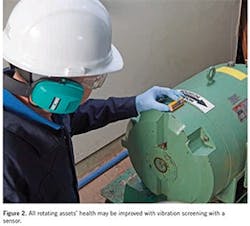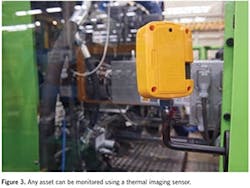Perspective: Cloud-based condition monitoring connects the dots
Just as a child must connect all the dots to reveal a picture, maintenance teams must be able to connect all of their data to have a complete picture of equipment health. With cloud-based software, remote wireless sensors, and handheld tools, technicians and managers can access condition-based data for any asset at any time using a PC or their smart devices. This article explores how teams can improve visibility and uptime of assets with sensors that send data to the cloud.
Benefits of cloud-based data aggregation
Maintenance teams face challenges as they begin the journey from a reactive to a proactive strategy. For plant managers who want to maintain uptime, engineers who value precise data to track asset health or the maintenance manager trying to stay ahead of failures, some cloud-based software can aggregate data from handheld tools used in route-based activities and the continuous data provided by wireless sensors.
This capability is important because many maintenance teams are planning to move to condition-based maintenance but still rely primarily on routes or time-based maintenance. Being able to aggregate data from these activities in one centralized location allows them to add sensors on assets that are critical to the system or process.
In addition to the benefit of having all data in one location, team members can also view data and receive alarms on smart devices wherever they are and at any time. Flexibility and the availability of data and alarm notifications are important in today’s facilities. For plants often being asked to do more work with fewer people, sensors can be eyes on the plant floor 24 hours per day.
The cybersecurity concern
Cybersecurity questions tend to rise to the surface and concern many potential end users. How safe is data stored in the cloud? Will plant IT personnel allow data to be transmitted to the cloud?
These are valid questions, but in most instances, the flexibility of any-time and any-location access makes cloud storage attractive. In a 2017 New York Times article, “Where Does Cloud Storage Really Reside? And Is It Secure?” Quentin Hardy observes that cloud storage often provides better data protection than on-site servers. “‘Cloud’ data is stored on hard drives (much the way data is usually stored),” he notes. “And yes, it’s probably more secure than conventionally stored data.” Data being looted and personal information becoming endangered has been much discussed, but “most of those attacks hit traditional servers,” he writes. “None of the most catastrophic hacks have been on the big public clouds.”
Another issue is that the IT department does not want other programs accessing the process and operation system. A benefit of cloud-based maintenance systems is that the process or operation servers are typically not accessed. If needed, maintenance data can be kept separate.
Concerns about cybersecurity are understandable when implementing cloud-based systems. However, cloud storage providers, such as Amazon and IBM, often have more security safeguards than private servers.
Technology choices
Handheld test tools will always be part of a maintenance and reliability strategy. For example, a piece of equipment that requires only monthly vibration testing because it is in a low-wear, nonaggressive application can be maintained through route-based monitoring unless problems arise. Similar cases can be made for routine electrical, temperature, and thermal readings on many assets.
On the other hand, wireless sensors can save time, improve labor efficiency and help reduce personnel risk when used to monitor assets in the following situations:
- Hard-to-reach locations
- Extremely hazardous environments
- Assets that show intermittent, hard-to-diagnose symptoms
So which sensors may be best to implement first? Based on the P-F curve, ultrasound technology is effective early, but conditional changes detected may be too early in the failure curve to necessitate action. Oil analysis and motor testing are two additional important analyses. For detecting when action may be needed, vibration and thermal imaging sensors are effective ways to detect abnormalities that may indicate potential failure when action may be needed.
Vibration monitoring sensors. One of the most intimidating technologies may be vibration. Experts train and are certified to be vibration analysts (levels I through IV). However, not all vibration monitoring is complex.
Taking a tiered approach to maintenance allows personnel at any skill level to take advantage of this method of asset monitoring. Depending on their criticality levels, assets need different levels of monitoring, and this helps teams set up a tiered maintenance strategy (see Figure 1). This type of strategy hinges on mid- to low-tier assets being screened with cost-effective, wireless sensors that identify conditional changes that indicate an emerging fault. The sensors can detect condition changes caused by faults such as misalignment, imbalance, looseness, and bearing wear.
Rotating assets’ health may be improved with vibration screening with a sensor, including pumps, fans, motors, blowers, compressors, and gearboxes (see Figure 2).
Thermal imaging sensors. Any asset can be monitored using a thermal imaging sensor. Screening with this technology detects condition changes that occur a little farther along the P-F curve. User-defined monitoring cycles (1-, 5-, 10-, 15-, 30- and 60-minute), are shorter than typical route-based thermal inspection intervals with a handheld infrared camera. With sensors, issues are identified as they develop, and maintenance and reliability professionals can assess how quickly they need to act and make appropriate maintenance planning decisions.
Using thermal monitoring sensors involves the basic identification of infrared images indicating hot and cold spots plus differences in temperature among similar units operating under similar conditions (see Figure 3). When monitoring equipment and performing thermal inspections of the asset’s components, such as bearings, shafts, casings, belts, gearboxes, and other components that emit heat, infrared sensors can be used as indicators of equipment condition. Teams are alerted to changes in these conditions with alarms on PCs or smart devices. This early warning helps prevent unexpected equipment breakdowns.
In some processes, thermal monitoring is ideal for identifying a lack of uniformity in equipment. For example, a thermal condition monitoring sensor can help facility managers spot temperate inconsistencies, such as a winding insulation failure, in a single motor. The cloud-based software builds heat profiles (via heat mapping) of a motor by capturing infrared images while the motor is fully operational under standard conditions.
Frederic Baudart is a product application specialist for Fluke Corp., focusing on digital systems and the company’s process, electrical, and mechanical product lines.
The images are taken at regular intervals from the exact same location (vs. the potential of different angles/locations with a handheld camera). For this reason, comparison is simple. Troubleshooting intermittent problems requires that personnel be in the right place at the right time, which is not always possible. Infrared sensors solve the limitations of a fixed camera because they are movable, do not require a cable connection to function, and are wireless.
Connect the data dots
To improve uptime, asset health, and labor efficiency, maintenance and reliability teams must aggregate all of their data in one place. Whether they have moved to primarily condition-based techniques or are using routes with handheld tools along with sensing technology, all teams can win with the flexibility and accessibility of data stored in the cloud. Alarms, real-time health parameters and trending data are all available, anywhere and at any time, with a hardware and software system.
A completed data picture is helpful because it allows maintenance professionals to make an appropriate decision instead of not knowing an asset’s health status and waiting for potential failure.



